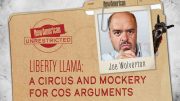
This article originally appeared in the June 12, 1995 issue of The New American
On May 19, 1994, Utah Governor Mike Leavitt publicly unveiled his controversial proposal to convene a Conference of the States for the purpose of promoting “fundamental, structural change” to restore a proper balance between the federal government and the states. Two days earlier, in a memorandum addressed to interested parties, Leavitt and his deputy for policy, LaVarr Webb, claimed that the Conference of the States process would be “powerful” because it “relies upon precedents established by the Founding Fathers at the time of our nation’s birth.”
Describing our current national government as “outdated and old-fashioned,” they asserted that “the problem we confront today regarding balance in the federal system is similar to what the Founding Fathers of this country faced more than 200 years ago with regard to the Articles of Confederation.” The duo declared that it is “vitally important to see how the Founding Fathers solved the problems of the weak Confederation,” since some of what occurred then “can help guide us today in restoring balance in the federal system.”
History reveals that the Founders called a meeting of the states, which became the constitutional convention, which, though convened for the purpose of revising the Articles of Confederation, scrapped the Articles in favor of an entirely new document.
Less Than a Con-Con?
In their May 17 memo, Leavitt and Webb expressed the hope that a process “less disruptive than calling a constitutional convention” can be achieved, but held out the possibility that if “Congress refused to consider or pass the amendments” that emerge from a Conference of the States, “the states would have the option themselves of calling a constitutional convention to consider the amendments.”
The governor’s proposal drew prompt criticism from conservatives concerned about its potential for instigating a constitutional convention. Leavitt “solved” the problem with a semantic adjustment, dropping all references to a con-con while keeping the original blueprint intact. A revised version of the plan, carrying his name alone, was printed in July 1994 by Utah’s two largest daily newspapers. The revision dropped the reference to “calling a constitutional convention to consider the amendments,” and asserted instead that “the states would have the final option of taking constitutional action themselves.” In addition, the reference to reliance “upon precedents established by the Founding Fathers at our nation’s birth” became reliance “upon principles established at the time of our nation’s birth.” (Emphasis added.) The switch from “precedents” to “principles” was viewed by some as an attempt to divert attention from the only precedent for a Conference of the States, which resulted in the only constitutional convention held to date in our country’s history.
The potential for a con-con was still there, to be sure. It was merely camouflaged in a way that misled many to believe that it had been abandoned. By January of this year, the Conference of the States had been endorsed by most governors, as well as by such prestigious organizations as the National Governors Association, the Council of State Governments, the Advisory Council on Intergovernmental Relations, and the National Conference of State Legislatures. Quick approval by at least a simple majority of states (26 of the 50) required to convene the Conference appeared to be a sure thing, and talk within pro-Conference circles shifted from whether the conference would be held to what its outcome would be.
Moving Ahead
The first step after a majority of states signed on was to be an organizing session in July, followed by the Conference itself in late October during which concrete proposals (including constitutional amendments) would be approved.
First to pass a “Resolution of Participation,” on January 16, 1995, was Governor Leavitt’s own state of Utah. To assure that he would have the honor of being first to sign the measure, the legislature passed it on the first day of the session (January 16) without hearings or debate. The vote was 75 to 0 in the House and 27 to 1 in the Senate. Two days later, Arkansas followed suit, also without hearings. On January 20, Virginia gave its blessing (without hearings), as did Delaware (without hearings) on January 26 and Kentucky (without hearings) the next day. On February 2, resolutions were passed with similar haste and lack of scrutiny in Idaho, Missouri, and Iowa. Ohio, Arizona, Wyoming, and South Dakota soon came aboard, and by mid-February the tally stood at 12 to 0 in favor of a Conference of the States. The juggernaut was rolling, and did indeed appear to be unstoppable.
But then the well-oiled Conference machine ran into a brick wall. Whereas early votes approving Resolutions of Participation had been taken in an informational vacuum, a grassroots opposition movement led by the John Birch Society and its nationwide network of educational activists began to materialize. The Birch Society had first drawn its members’ attention to the threat posed by the Conference of the States in its January Bulletin, where Don Fotheringham, the Society’s point man on the issue, warned that the Leavitt plan was “potentially more dangerous than legitimate calls for a con-con. The governor, it seems, has concocted a whole new strategy for making radical changes to our form of government — a strategy that conflicts with the amendment procedures provided by Article V in the U.S. Constitution.” While acknowledging that the current federal-state balance “tilts to the far left in favor of federal power” and “is in dire need of correction,” Fotheringham stressed that “no legislative or structural alterations can properly be obtained by any joint activity of state executives.”
To date, the most useful educational tool exposing flaws in the Conference of the States has been Fotheringham’s article, “Con-Con Call,” which appeared in the March 6, 1995 issue of The New American. Once that article began to circulate widely, demands for legislative hearings increased and many lawmakers were made aware of the ominous implications of the proposed Conference for the first time.
The Grassroots Grow
Serious grassroots opposition to the Conference of the States initially surfaced in Colorado. The Senate approved the resolution in mid-February, but by a surprisingly close vote of 21 to 14. The measure had been expected to pass with minimal opposition. Spurred by Birch Society activists and other concerned citizens, the House Judiciary Committee scheduled hearings.
On February 16, the John Birch Society’s Don Fotheringham testified against the Conference. Fotheringham recollects that during his testimony he told the committee that our country’s Founders “understood their sovereignty. They exercised it in liberating themselves from England, in issuing the Declaration of Independence, in establishing the Articles of Confederation, and in ordaining the U.S. Constitution. They understood the power that resides in a free people, the power to create a government, and the power to disband one.” Fotheringham testified that Resolutions of Participation in the Conference “would consolidate those same powers, no matter what the meeting may be called.” In passing such a resolution, he advised the lawmakers, “You establish a delegation that is no longer accountable to the legislature of Colorado. The process of appointing delegates to meet with a majority of the other states to conduct federal business releases them from all accountability to this body. That is because, in a federal setting, such delegates are accountable only to the people. That is the legal, the peaceful, process by which the revolutionary force of a sovereign people is consolidated.”
Commenting on attempts to add mollifying amendments to the resolution, supposedly to make it con-con safe, Fotheringham described such efforts as worthless, since “no amendment could be written that would have more power than the forces consolidated by this process. Delegates of the people are superior to Article V. They are superior to the Constitution. They are the creators of constitutions, presidents, courts, and congresses.” *
At the conclusion of the day’s testimony, Senate Majority Leader Tim Foster, who had spoken in favor of the resolution, urged the committee to postpone a vote until a majority of other states had passed their resolutions. That way, Colorado could avoid defeating the measure and thereby slowing momentum for the Conference. No vote was taken, and the resolution died when the legislature adjourned for the year on May 8.
Off Track
On April 2, 1995, the Salt Lake Tribune reported that Governor Leavitt’s policy director, LaVarr Webb, had “traveled to Sacramento in March to help guide California’s formal ‘Resolution of Participation’ to passage. There, in a legislative committee room, Webb stared down dozens of angry conservatives worried about undermining the Constitution. The California lawmakers killed the resolution” by a vote of four to one. Tribune reporter Laurie Sullivan quoted Governor Leavitt as saying: “They had 80-some-odd people turn out to the hearing. They were booing and demonstrating. LaVarr was basically the only [supporter] there.”
According to Sullivan, “In a span of just weeks, the John Birch Society has heaved the conference locomotive offtrack.” For his part, Webb told a reporter for Salt Lake City’s Deseret News that “there is a lot of opposition from the real extreme right-wing wackos,” whom he described as “irrational” and unwilling to “listen to reason.”
As we write, Resolutions of Participation have passed both houses of legislatures in 14 states, but have been scuttled in 20 others, including:
Indiana. Representative Dean Mock was instrumental in keeping his colleagues up to date regarding the ominous implications of the Conference of the States. Two slightly differing resolutions languished with little support in either the House or Senate. They died when the legislature adjourned for the year on April 30.
Louisiana. Don Fotheringham testified against the Conference on March 29, but the state’s House Government Affairs Committee approved the resolution that day by a narrow six to five vote. On April 18, however, the full House voted down the resolution by a margin of 57 to 27. Babs Wilson, a parish chairwoman of the Republican Party, played a key role in generating opposition to the resolution.
Maryland. After identical Conference resolutions were introduced in the Senate and House, local John Birch Society members Ben and Betsy Boyce arranged for Don Fotheringham to testify during hearings held in the Senate on February 28 and in the House the next day. Summarizing his “Con-Con Call” article from The New American, Fotheringham urged the Maryland lawmakers to read the article and carefully consider what a Conference of the States would actually entail. When he indicated to committee Chairman (and Senate Majority Leader) Clarence Blount that he was nearing the end of his testimony, the chairman asked him to instead “please go on,” which he did. No vote was taken that day.
During the next day’s hearings before the House Commerce and Government Matters Committee, Colorado State Senator Duke made a strong case against the resolution, explaining the uncertainty of the ratification process even were the Conference to comply with Article V and submit its action plan (States’ Petition) to the states.
In testimony Fotheringham cited Utah’s experience during the debate over repeal of prohibition. Utah was a “dry” state, due in large part to the influence of its heavily Mormon population, and all members of the legislature had agreed to vote against the 21st Amendment. When Congress and the liquor lobby realized that the legislature of Utah and many other states had no intention of ratifying the 21st Amendment, Congress exercised its Article V option to circumvent the legislatures by authorizing state ratifying conventions instead. Congress and special interests then influenced the delegate selection process to assure that even “dry” states would pass the anti-prohibition amendment. It was by that strategy that Utah, ironically, became the 36th and decisive state to legalize the sale of liquor, despite overwhelming opposition from the state legislature.
Maryland’s Senate committee opted to postpone a vote on the Conference matter. But on March 13, the House committee rejected the resolution by a lop-sided tally of 16 to 4, thereby laying it to rest for the year.
Montana. Hearings were held in the Montana House on March 14. Again, Don Fotheringham was there, as were Montana Governor Marc Racico and Governor Leavitt. It was the first time that Fotheringham and Leavitt had faced each other during a hearing. The governors were allowed to speak both first and last. In between, Fotheringham focused on the enormous power that could be wielded by the Conference due to the Resolutions of Participation process. He explained why the action plan produced by the Conference would not necessarily come back to the state legislatures for ratification, and made clear that the John Birch Society was not accusing Conference sponsors of attempting to hold an Article V convention per se, but rather of consolidating the forces that would amount to such a convention.
As Fotheringham has pointed out on other occasions, delegates to the Conference of the States would already have the con-con power, so there would be no need to announce to the world that it was a con-con. If and when 26 legislature-approved Resolutions of Participation are secured, the delegates to the Conference “can do whatever they please, whether they call it a constitutional convention or not.” The resolutions, Fotheringham stresses, are the problem. “They energize the concept. When you meet in a federal setting with other states to do federal business, you are a con-con whether you call it one or not.”
The hearing was thorough, both sides were given ample opportunity to make their case, and the event was extensively covered by both the print and electronic media. The House committee opted not to vote that day, but later rejected the resolution (March 14) by a vote of six to five.
New Mexico. On March 7, Fotheringham arrived at the state capitol in Santa Fe to give testimony at hearings which, according to the day’s printed agenda, were to be held on the House side. It soon became apparent that a proverbial “fast one” was being attempted, since the House hearings were merely for the purpose of appropriating expense money for Conference delegates. Some sleuthing by Fotheringham and John Birch Society members Lee Gonzales and Gary Krieger eventually determined that the Conference, under another name, was being scrutinized by the Senate Rules Committee. The three arrived at the hearing room as Senate Minority Whip Timothy Jennings was about to call for a vote. Jennings mistakenly assumed that Fotheringham was representing Mike Leavitt, and told him, “Governor Leavitt offered to come here today, but I told him I didn’t think it would be necessary and that we had everything all worked out here.” After allowing brief statements by Fotheringham, Gonzales, and Krieger, the committee passed the resolution unanimously. It was subsequently approved by the full Senate and sent to the House Judiciary Committee.
The bill was placed on the House calendar for March 15. By law, the legislature would adjourn by noon on March 18. No hearings were held on the 15th, nor at any other time. Over the next four days, however, a number of key legislators availed themselves of the opportunity to study the issue more thoroughly. At the last moment, only three minutes prior to adjournment, the House Speaker called up the Conference resolution for a vote. He claimed that there was no longer a con-con problem, since the measure had been amended to preclude one. Thanks to some last-minute floor work by State Representative Lorenzo Larranaga, however, it quickly became apparent as the voting lights flashed that a major upset was in the making. The resolution went down to defeat, 42 to 21.
Other states in which the Resolution of Participation has either been voted down, or the legislature has adjourned without passing it, include Florida, Georgia, Hawaii, Kansas, Minnesota, Mississippi, Oklahoma, Oregon, Pennsylvania, Rhode Island, Vermont, and West Virginia.
New Strategy
The Conference of the States will not be held in 1995 as planned. Governor Leavitt and other spokesmen admit that burgeoning grassroots opposition has forced them to cancel the July organizing meeting and to postpone the confab itself that was originally scheduled for October 22-25 in Philadelphia.
On April 21, the Conference of the States steering committee, chaired by Governor Leavitt, met in Florida to figure out how to reverse the misfortune that has befallen the Conference cause. Earlier, Leavitt had indicated that he might be willing to forego the Resolutions of Participation, which would solve the problem, but the steering committee (with his support) decided to not only keep the Resolutions as part of the process, but increase the effort to achieve passage by a majority of state legislatures next year. Leavitt himself questioned whether or not it would be possible to attract governors and other state leaders to the Conference if the Resolutions were abandoned, since it would be perceived as a defeat, and there would be a risk of losing top-level delegations because they would have lost a sense of urgency.
The steering committee also decided to launch a massive effort to establish a fund-raising and lobbying entity to help spread the pro-Conference message to state lawmakers prior to legislative action next year. According to a March 25 report by the Salt Lake Tribune’s Laurie Sullivan, the “American Legislative Exchange Council [ALEC] and the State Legislative Leaders Foundation will join the Council of State Governments, the National Governors Association, and the National Conference of State Legislators as official conference conveners.” ALEC has for many years advocated a constitutional convention, if necessary, to achieve approval of a balanced budget amendment. The Washington-based Heritage Foundation, which periodically lends its aura of conservatism to questionable causes (it backed GATT and NAFTA, and is presently urging that NATO be expanded to include “former” communist countries that the U.S. would be obligated to defend), is, according to Governor Leavitt, one of the entities “drafting scholarly position papers stating the conference could not, would not become a constitutional convention.”
As noted earlier, the Conference resolution has passed in 14 states, but has been rejected by vote or inaction in 20. As we write, the count since mid-February stands at two for and 20 against the Resolutions of Participation. It is an impressive turn-around, but is also merely the first skirmish in what could prove to be a long, drawn-out conflict. Those who would defend the Constitution by opposing the Conference must guard against complacency, and redouble their efforts in coming months, lest they risk the fate of the hare that raced the tortoise in Aesop’s instructive fable.
Plans are presently underway for a “federalism summit” this autumn which, Conference promoters hope, will attract the support of at least 26 states. If that magic number is reached, Governor Leavitt has said that the “summit” will be transformed into a “convening meeting” at which governors and legislators will make plans for a future Conference of the States. Otherwise, the event will simply proceed as a “summit,” and may include not only governors and legislative leaders, but “perhaps even mayors, city councilmen, members of the courts — both state and national.” It will, Leavitt predicts, “be an important watershed event in and of itself.” As for the Conference of the States, he speculates that “it will happen, and it will happen sometime, but it doesn’t have to happen immediately.”
*In a number of states, one or the other (or both) of two amendments have been appended to the resolution in the attempt to appease critics. They read: “Adoption of the Resolution does not constitute an application by the Legislature of [State] for the calling of a federal Constitutional Convention within the meaning of Article V of the United States Constitution”; and, “The Conference of the States may not be convened as a federal Constitutional Convention under Article V of the United States Constitution.”
Related articles:
One Legislator’s Warning: Beware the Conference of the States
Con-Con Call: Beware Mike Leavitt’s “Conference of the States”




